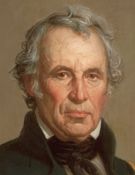 Zachary Taylor became the 12th president of the United States after being a national hero as the major general who led the United States to victory in the Mexican–American War in 1848. He ran on a platform to preserve the union in its battles over slavery. He died after only sixteen months in office, with a vague diagnosis of “food poisoning.” He had suffered five days of very high fever, bloody diarrhea, vomiting, and a belly that was so incredibly painful that he wouldn’t let his doctors touch it. Some believed that he had been poisoned by people who were angered by his anti-slavery stance.
Zachary Taylor became the 12th president of the United States after being a national hero as the major general who led the United States to victory in the Mexican–American War in 1848. He ran on a platform to preserve the union in its battles over slavery. He died after only sixteen months in office, with a vague diagnosis of “food poisoning.” He had suffered five days of very high fever, bloody diarrhea, vomiting, and a belly that was so incredibly painful that he wouldn’t let his doctors touch it. Some believed that he had been poisoned by people who were angered by his anti-slavery stance.
Early Years, Military Career and Presidency
Taylor’s parents were wealthy plantation owners who moved from Virginia to Louisville, Kentucky, where his father bought 10,000 acres and kept more than 26 slaves. His mother had taught him how to read and write at home because Kentucky did not yet have many schools . He never did learn to write clearly enough for his handwriting to be legible.
In 1808, at age 24, Taylor became an officer in the U.S. Army. As a captain during the War of 1812, he built forts along the Mississippi River. As a colonel in 1832, in the Second Seminole War, he was so brave in leading charges into enemy lines that he was called “Old Rough and Ready”. In 1846, he was the major general who led the United States to victory in the Mexican–American War. Under Taylor’s command, future president Ulysses S. Grant said, “A better army, man for man, probably never faced an enemy than the one commanded by General Taylor in the earliest two engagements of the Mexican War.”
In 1846, the Whig Party convinced Taylor to run for president, and he became the first U.S. president who had never served in any other elected position. To his credit, this Southerner who continued to own slaves tried to stop the expansion of slavery into California and New Mexico.
Marriage, Children and Death
In June 1810 at age 26, Taylor married Margaret Mackall Smith, the daughter of a soldier in the Revolutionary War and they had a daughter who married a U.S. Army surgeon; a daughter who married Jefferson Davis, the future President of the Confederate States; and a son who became a Confederate Army general.
On July 4, 1850, Taylor ate large amounts of raw fruit while attending a fund-raising celebration at the construction site of the Washington Monument, and then went back to the White House where he ate a large bowl of cherries and drank unpasteurized milk and water.
• That night he started to feel sick, vomited a few times and his belly started to hurt.
• The next day he developed bloody diarrhea.
• His temperature rose very high, so he called his doctor.
• The doctor told him he must have cholera, gave him calomel, opium and quinine, and drew blood, because doctors at that time treated almost every disease with blood-letting.
• He continued vomiting, his belly cramps worsened, and his bloody diarrhea become explosive.
• His belly pain was so severe that he cried out when the doctors tried to touch his belly.
• His temperature kept rising higher and higher and he died in his bed on the evening of July 9th, the fifth day of his illness, at age 64.
What Killed Zachary Taylor?
His doctors thought he had eaten spoiled food, but “food poisoning” doesn’t usually cause a fever that keeps on rising to very high levels. Other doctors thought he died of malaria, because he had been very sick with malaria when he fought in Mexico, but malaria is not characterized by vomiting and diarrhea.
Immediately after his death, it was rumored that the president had been poisoned by pro-slavery Southerners who were upset with his moderate position on slavery. The most common chemical used to poison people of that period was arsenic. However, arsenic poisoning does not cause high fever, diarrhea or vomiting. In 1991, 150 years after his death, his descendants had his body removed from its Kentucky grave and sent samples of his hair and fingernails to Oak Ridge National Laboratory in Tennessee. Arsenic levels were well below levels that could have killed him.
The Probable Diagnosis
The perfectly healthy president ate a lot of food on a hot day and then quickly developed diarrhea, vomiting and fever. Several of his cabinet members who ate the same food at the 4th of July celebration also came down with fever and belly pain. These symptoms had to be caused by an infection. High fever is a hallmark for infection with intestinal bacteria called salmonella typhosa. The extremely painful belly that hurt so much when doctors touched it was probably caused by a rupture of his intestines that leaked intestinal contents into his belly. He probably died from the food-borne infection that was common in those days called typhoid fever.
In 1850, the city of Washington had open sewers that contaminated the residents’ food and drinking water, to infect them with many different stool-borne germs. Taylor’s doctors didn’t help him by giving him potentially lethal doses of ipecac, calomel, opium, and quinine, and draining large amounts of blood from his body. Today, he could have been cured by taking antibiotics.
Zachary Taylor
November 24, 1784 – July 9, 1850

